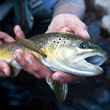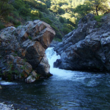When I was asked to write about pursuing striped bass in the fall and fly fishing techniques used to target them, I almost passed on the offer. I thought back on how, 20 years ago in my home state of New Jersey, you could walk down to a jetty or groin on the right tide, time of day and pick away at all the schoolie bass your heart desired simply by throwing an appropriate pattern into the rock pockets and letting the fly breath in the tide.
We did this back then with a floating line, mostly 8 and 9 weight sticks and stripping baskets. The idea behind the floating line was to keep hammering the pockets using a quick water haul and to keep presenting the fly to a target in a coordinated rhythm with the surge. A jetty ace from back then used to call this process 'fishing the hydraulics'. It was killer. And, of course, there were fish everywhere -- which made the whole picture complete. Variations on this approach involved using poppers or crease flies and changing patterns appropriately as the bait changed, but always using floating lines. The presentations were generally very short in duration and you timed your casts between waves so the grab of the floating line by the surf never became an issue.
As years passed, more and more fly anglers ventured to sink tips or full sink and intermediate lines and employed a style of fishing I typically refer to as 'covering ground'. These tactics are an effective way to fish, but are as different from fishing the hydraulics as blind casting is to sight casting. Repeatedly blind casting to quadrants is a dramatically different fishing experience than the visual one that comes with casting to a fish boil behind a rock or nervous bait in a close rip.
Looking back, it is likely that the evolution in the strategies used to target striped bass on the fly were more a reflection of changing fish populations than the individual angler's choice. As the striper population declined in our region, which it has dramatically, the days of 'banging jetty pockets' faded away and the fishery morphed into more of a run and gun scenario. It has become a necessity to cover as much ground as possible and expose as much water as you can to your fly. It isn't that doing so is a more effective way to fish. It's that there are fewer fish. Much fewer.
This leads me back to why my first inclination was to pass on the request to put together a piece on targeting bass on the fly in the New Jersey salt: when pondering the request, I found myself wondering how to go about writing about strategies to employ in a fishery that no longer exists, at least not substantially enough to justify a piece about how to approach it with a fly rod. If you think I'm overstating things, all you have to do is look at the surf fishing blog reports over the past few seasons for the fall run on the jersey Coast. It's depressing. And it doesn't matter whether you're using spin gear, a fly rod or a crossbow. Sure, there still are the occasional fall beach blitzes in central and northern New Jersey and some good -- albeit sporadic -- spring pickings with the smaller bass that congregate around Delaware Bay. But in the larger scheme of things? Guess what folks? There's not much of a fishery left.
I hate politics. But like it or not, the fate of the striped bass in the Atlantic Ocean is in the hands of our politicians. The future of the bass hinges, as it has for as long as I can remember, on whether federal and state legislatures find a way to develop comprehensive regulations that can not only enhance natural upticks in the population of striped bass along the shores of the Atlantic coastal states, but also buffer and protect this population during its natural downturns.
The Atlantic States Marine Fisheries Commission (ASMFC) was formed back in 1942. It was membered by 15 coastal states with the recognition that fish do not adhere to political boundaries. In collaboration with the feds, its job was to oversee the management of certain migratory species, including striped bass. Several decades later, in the 1970s, a sharp decline in the striped bass fishery prompted the council to pass legislation, eventually resulting in the Atlantic Striped Bass Conservation Act of 1984. This act enabled federal imposition of a moratorium on the striped bass fishery in states which failed to comply with the ASMFC fishery management plan, but left the coastal states with principal management jurisdiction over striped bass n their states waters. The feds control the fishery outside of 3 miles in the EEZ (federal waters).
There is no question that these regulations played major role in enhancing the natural upswing of the striped bass cycle . But I, and many others, highly question wether they are of much value in supporting the population sufficiently through the looming down cycle. While these regulations were no doubt instituted with the best of intentions -- and most certainly resulted in back slapping and high fives all around when the bass population resurged in the 90s -- they continue to present a fragmented, inconsistent management picture that may fail to create a sufficient buffer in the striped bass population as it stages through a cyclical downswing.
Whether a given fish winters in North Carolina and travels north to Massachusetts in the summer, or only moves annually between the Hudson River and Rhode Island, that fish may be afforded game fish status during part of his journey but open to commercial harvest during another. A fish may be dead meat at just over 18 inches in one state but safe in another as long as he is under 28 inches. God bless that fish if she is a big cow breeder, as she is legally harvestable in almost all coastal states.
This reality is, we've heard the political mumbo jumbo that keeps the current state-centric, fragmented management practices in place discussed over and over again on the editorial page of outdoor magazines and blogs, back and forth and every which way until you you're ready to puke. Yet, the situation remains unchanged. It's the biggest political charlie foxtrot those of us in the fisheries world have ever faced. And it's going nowhere.
If, a decade from now, I'm once again asked to write an article about the Atlantic striped bass fishery, that article may not have a happy ending. If it does, it will be because our representatives found a way to unify and standardize protection laws for striped bass in the coastal states in coordination with the feds. Laws that make sense not politics.
I hope to be back in ten years.





























Comments
mkjames replied on Permalink
Why would the debate over striper regulations be different than the debate over salmon in Bristol Bay or any of the countless other arenas in which economic gains for the few are favored over resource preservation (and long term economic benefit) for the many?
Unfortunately, the few that stand to benefit from short-term abuse of our natural resources are usually those with the heavy wallets, and those which can mold the system to fit their needs.
DirkFunk replied on Permalink
There is only one answer. Gamefish status, 1 slot limit fish per person per day.
DDon replied on Permalink
You think that stands ANY chance of happening? Seems like way too many old heads.
Plus, striped bass are delicious (possibly my favorite eating fish). It's not like convincing people to give up bonefish, which hardly anyone wants to eat in the first place.
jeff nichols replied on Permalink
What about the 3 tons (Three Tons!!!) of fish found in just one illegal submerged gill nets in MAryland two years ago?? And the estimated 20 tons of bass abstracted and culled from the Bio mass of fish in NOrth Carolina three years ago?..... hard to believe that did not impact fishing...why wernt these bigger stories...where was the national media on this?... 60 minutes not a good enugh story for you??... ..sad...the striped bass is a historically important fish. and BY the way..were does 3 tons of rock fish get shiped to , what name is it being served under? Who is buying it.... lets not just blame the rec guy..when there are larger distribution apparatuses in place.
ginkthefly replied on Permalink
Why weren't these bigger stories indeed?
Do you have links to any info on these instances, Jeff? Would love to learn more about them.
Jeff Nichols replied on Permalink
Hi Ginkthefky,
they are all well documented on You tube. (outer BANKS STRIPED BASS MASSACARE) ( Maryland gill NET ROCK FISH....ECT) ..and I think the Baltimore sun ran a piece or two on it....but still LIGHT COVERAGE... if someone slaughtered 10,000 bald eagles you bet Operha would be talking about it..
Small plug..Zack Harvey goes into good detail on what happened in both states in the "afterwards" in the book I wrote call "caught". re a court case I was in with NY DEC
ginkthefly replied on Permalink
Thanks, will follow up.
What strikes me most is what you noted -- where are these fish going once harvested? I too love to eat striped bass, but I eat one or two a year that I catch.
They're so rarely seen on the menu anywhere. Usually only at higher end restaurants and seafood menus.
It turns my stomach to think of a massive hauling of such a prized fish going bulk into some fish patty or other "seafood" product.
HermanY replied on Permalink
They're still way too valuable to be ground into fish patties. That's the fate of milkfish, tilapia, pollock and other cod family fish.
I live near Washington DC, so I see a good number on restaurant menus, though the definition of "high end" varies by person and location. I also see quite a few in either gourmet supermarkets (usually priced high and with some kind of sustainability certification) or in the "international" supermarkets.
Being of Asian descent I frequent the latter markets but refuse to buy their stripers. Many of them look dubiously legal and there's no pretense of sustainability. Point of origin is "NY." What look to be schoolies are listed as "farm-raised" or "hybrids" but at suspiciously low prices. Demand doesn't seem that high, people usually walk out with salmon, tilapia or mackerel, but the stripers are always there.
On the upside, the introduction of farmed bronzino/European seabass, seems to have filled the restaurant and supermarket gap at least in DC and NYC.
On the media coverage issue, the problem I see is that this is a food animal and a fish. News that someone has illegally taken some kind of fish you might eat twice a year isn't as interesting as someone killing bison or eagles.
HermanY replied on Permalink
The rumor going around my fishing club in NYC was that the poachers would load up their coolers and just drive around to restaurants and sell the stripers at the backdoor for cash. The consensus was that there were too many stripers available at too many restaurants in the tri-state area to be accounted for by whatever the legal commercial haul was in NY, CT, RI and NJ.
Bob Triggs replied on Permalink
STOP KILLING WILD STRIPED BASS! !!
Pete McDonald replied on Permalink
This is a great article and made me think for the first time about how technique reflects the shifting baseline. I started striped bass fishing in the 1990s but almost always fished by boat. When I started beach fishing a few years ago I became indoctrinated in the "covering ground" philosophy and floating line was just for the occasional blitz situation. Even when I go by boat now the old "can't miss" places at the right time and tide are more often swing-and-a-miss -- especially compared to even 10 years ago.
Pages